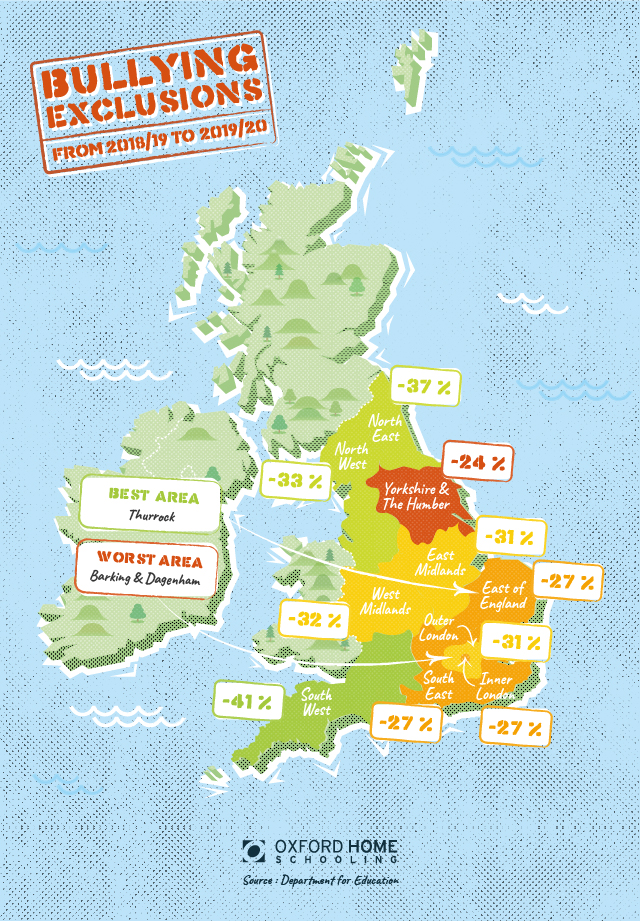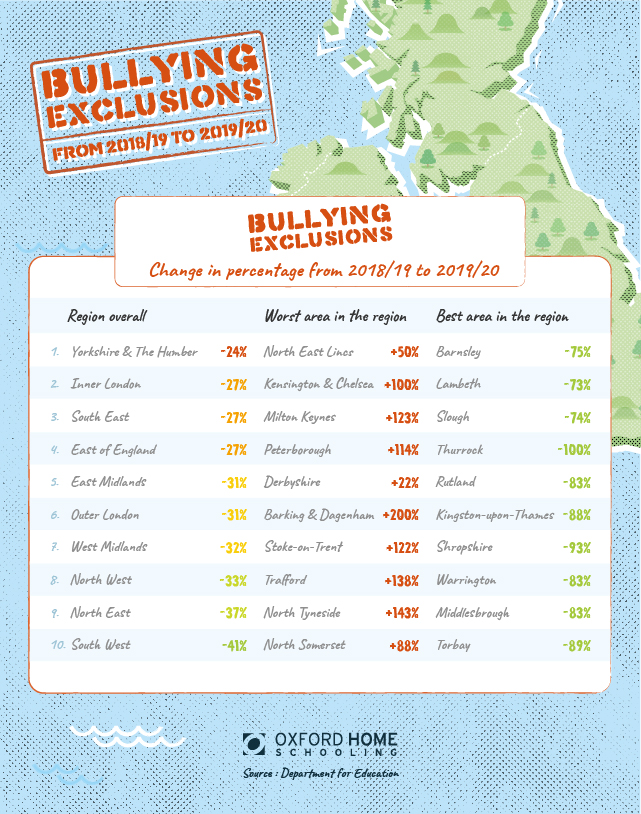Revealed: England’s biggest lockdown bullying hotspots

- Barking and Dagenham has seen the biggest increase in school bullying exclusions during lockdown – a 200% year-on-year rise
- 10 local authorities saw bullying rates more than double between 2018/19 and 2019/20
- Across England, the average number of exclusions for bullying has dropped by 31%
England’s worst areas for school bullying during lockdown have been revealed in new research that has explored the number of exclusions across the country.
Using the latest Department for Education data1, released yesterday, Oxford Home Schooling identified the regions which have experienced the biggest increases and decreases in bullying exclusions between 2018/19 and 2019/20.
Barking and Dagenham is the biggest lockdown bullying hotspot, with the local authority seeing a 200% increase in the number of suspensions and permanent exclusions for this reason compared to the previous school year.
The London borough is followed by North Tyneside, which experienced a 143% increase, and Trafford, where the number of bullying exclusions rose by 138%.
Across England, ten local authorities saw their figures more than double.
The local authorities that reported the biggest increases in bullying exclusions were:
- Barking and Dagenham – 200%
- North Tyneside – 143%
- Trafford – 138%
- Milton Keynes – 123%
- Stoke-on-Trent – 122%
- Peterborough – 114%
- Isle of Wight – 114%
- Kensington and Chelsea – 100%
- Halton – 100%
- Sutton – 100%
However, the national picture looks far more positive, largely due to school closures affecting the amount of contact time students had together.
In England, the number of bullying exclusions dropped by 31% from 3,450 to 2,456 – equivalent to 63 such exclusions a week, compared to 91 the year before.
In 2018/19, there was one bullying exclusion per 2,327 pupils in the country, but this has risen to one per 3,385.
Thurrock, in the East on England, saw the most significant improvement, with a 100% decrease seeing its bullying exclusions drop to zero. Shropshire also experienced a large fall, with a 93% decline.
In fact, every English region saw its figures plummet. Schools in the South West are the best performing in this regard, with the area experiencing 41% fewer bullying exclusions in the last year compared to the previous period.
In contrast, Yorkshire and the Humber saw the smallest decrease, but still reduced its figure by 24%.
The English regions which saw the biggest and smallest decreases in the number of school exclusions for bullying are:
- South West – 41% decrease
- North East – 37% decrease
- North West – 33% decrease
- West Midlands – 32% decrease
- Outer London – 31% decrease
- East Midlands – 31% decrease
- East of England – 27% decrease
- Inner London – 27% decrease
- South East – 27% decrease
- Yorkshire and the Humber – 24% decrease

Greg Smith, Head of Operations at Oxford Home Schooling, said: “These new exclusion figures cover the whole of the 2019/20 school year, but with the final term being conducted during lockdown, it’s interesting to see how the data compares to previous totals.
“In many ways, the measures introduced during the pandemic, like reduced class sizes and increased supervision, have helped address the country’s bullying problem, so it will be interesting to see if schools try to adopt some of these permanently, even though restrictions are easing.
“Anecdotally, nearly half of the parents who enrol their children with Oxford Home Schooling list bullying amongst their reasons for doing so. If your child is being bullied at school, then home education is a viable solution.”
To see which local authorities in each region saw the biggest increases and decreases in bullying during lockdown, visit: https://www.oxfordhomeschooling.co.uk/blog/how-lockdowns-have-impacted-school-bullying/

